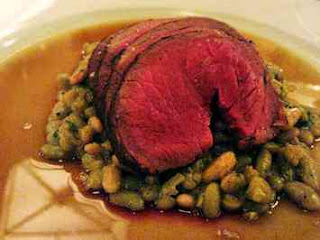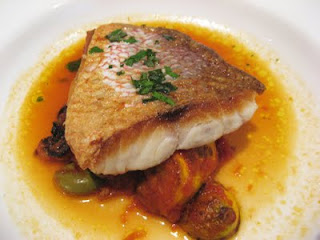I first learned of Keller on my first day of hospitality school, when the chef instructor of my cooking class held up his book and said "This will be your textbook. Read it if you want, as there will be no tests on it. But reading it will help you understand the mind behind the greatest chef of our era." I scoffed at the notion of "a greatest chef" and did not buy the book. I could also not conceive paying a hefty $50 for a cookbook. However, a tiny seed was planted in my head. The concept of using fresh ingredients according to the seasons, the idea of cooking as a legitimate profession...these were novelties to me. It was not until three years later that I actually bought the book to read on my own--long after class had ended--to gain the insight into Keller's mind the instructor had spoken of. By this time I had already read every review, interview, and watched every video imaginable of The French Laundry, Per Se, and Keller. The book was the next step...
Opening up The French Laundry Cookbook, you quickly understand why this man is gifted. He has the ability to take the simplest of ingredients--such as carrots, leeks, and potatoes--and through his cooking transcend them into another world of flavor and texture altogether. Yet, when you look at the dishes, they don't seem complex. This is what makes him special--he can make incredibly difficult cooking techniques seem simple on the plate. The French Laundry cookbook is more than a listing of recipes. He devotes entire pages to talk about his transformation as a cook into a chef, the special purveyors he uses, and the inspirations for the dishes. It is full of countless tips, such as to "run the back of your knife over the skin of a fish filet to remove excess moisture so the skin will crisp nicely when searing."
After reading the book, and even attempting the Pig's Trotters (feet) recipe, I knew I had to pay a visit to one of his places. I had applied to work at The French Laundry back in early 2010, and a month later received notice that they would like to interview me. Within 3 or 4 days, I was already in Napa, staying at a bed and breakfast just 50 feet away from the temple of gastronomy that is The French Laundry. That evening, soaking in the beauty that is Napa, I decided to have dinner at Bouchon.
As an appetizer, I had a Petit Cassoulet de Lapin et Foie Gras. It was a black stock pot casserole of rabbit leg confit, foie gras, heirloom beans, and rabbit jus. I can't recall ever tasting rabbit before this, and every rabbit I've had since I compare to this. It tasted so incredible and rich, words can almost not describe (this will become a theme throughout this post!). It could have easily been an entree since the portion was so big, yet it was priced as an appetizer! It was rustic food cooked with flawless technique.
As an entree, I enjoyed a Gigot d'Agneu (leg of lamb). It came over a bed of English peas, turnips, rhubarb, and a natural lamb jus that was poured tableside. The lamb was most likely cooked sous vide, as it was a perfect medium rare all the way around. It was delicious, but what shocked me even more were the peas and vegetables on the plate. They were harvested right from the French Laundry's farm down the street. Due to this, their taste and texture were incredible. I now know what peas should taste like. Anything from a can just won't cut it anymore.
For dessert I had a Creme Caramel. It was a simply prepared caramel custard. It was good, but nothing like the flans you can find in Miami (or in my dad's kitchen).
Over all the meal was very nice, the service knowledgeable and professional, and the price very affordable for the portions received.
Across the street he has Bouchon Bakery, a small shop where all the breads are baked for the restaurants. You can buy pastries and breads there. Just down the street as well is Ad Hoc, Keller's version of a casual family restaurant.
I can only hope Keller opens a Bouchon in NYC. I'd become a regular in a heartbeat. Until then, you can only experience a Bouchon meal in the West Coast. However, he has some bakeries in New York, along with Per Se.































































